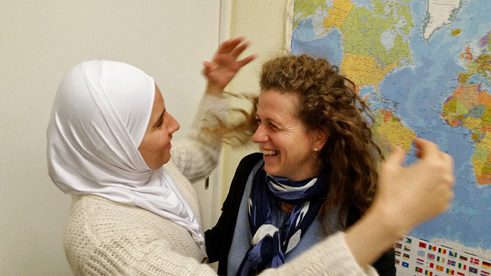By the end of 2015 Germany will have taken in almost a million refugees. Most of the people helping in the reception centres are working there on an unpaid, voluntary basis. How does it work when two different cultures come together? We went to Berlin to find out.
Loud oriental music blares out of the former town hall in the Berlin district of Wilmersdorf. In December 2015 there are about 1,000 refugees living in the former offices of the town hall, which the administration had to give up for reasons of cost. By the end of 2015 Germany will have taken in almost a million refugees from various war zones and trouble spots.
On the third floor there is a room reserved for women where female refugees and voluntary helpers can enjoy some privacy. The mood this afternoon, however, is particularly elated. Refugees from Syria, Afghanistan, Iraq and other countries have just finished their German course. While the men are out and about on official business, applying for residence permits or asylum in Germany at the various offices, the women are in high spirits dancing on the carpet, swaying their hips in a kind of belly dance. One woman suddenly trills a very high, shrill tone – an expression of great joy.
Happy because they survived
“They are happy that they are still alive. That is not something to be taken lightly,” says Heike, one of the German helpers, who regularly spends time at the accommodation centre. One of the women told her about how she had crossed the Mediterranean to Europe in a rubber dinghy and how dangerous it was. Another woman, Hend from Syria, showed her photos on her mobile phone of her modern house in Damascus that she had to leave behind in the bombed out ruins of the city.
Heike and Hend have in the meantime become the best of friends. The Syrian woman had studied and taught English in Damascus. The German woman, a free-lance photographer, also speaks good English. Between the other refugees and voluntary helpers, on the other hand, there are huge language barriers. Sometimes some women who can speak Arabic or Farsi help out as interpreters, but they, too, have difficulties if they have to interpret for people who have been traumatised.
200 helpers a day
It is these voluntary, unpaid helpers who set up the Women’s Room and who run it – the same goes for the playroom for the almost 300 children, the clothing store, the medicine rooms and the donations acceptance point. Everybody calls each other by their first name and they use the informal “du” form for the word for you, which is not always so common in Germany. Every day there are about 200 of these volunteers working in the building on a shift basis, among them there are doctors, psychologists, teachers and interpreters, says centre director, Thomas de Vachroi. There are only a few permanent employees. The voluntary helpers organise themselves via the Internet, their Facebook group has more than 5,000 members.The voluntary helpers are “paid” in a very special currency – it is the feeling of pure joy they get, working together for a good cause, many of them say. Sociologists call this feeling a “Helper’s High”. “It’s so moving,” says Patricia – the tears welling up in the nurse’s eyes. Back in 2010 she had travelled round Syria, before the civil war of course, and she was met with tremendous hospitality. Now she wants to give some of that back.
Building cultural bridges
To give something back is what a lot of Berliners would also like to do - especially those who come from a foreign background themselves. On the ground floor we find a Kenyan-born woman called Wambui sorting out all the various things that have been donated, in the canteen we find Swedish-born Madeleine and American-born Lynn dishing out portions of beans and rice in a curry sauce. They are happy to be doing something that is obviously useful. We often hear about helpers elsewhere being exhausted and at the end of their tether, no sign of that here.
Other cultural bridges have also been built. In the stricter sense of the word, when the orchestra of the Berlin State Opera gave a concert at the refugee centre, but also on a day-to-day basis. “I never look refugee women in the eye. That can be misunderstood in their culture,” explains a male helper called Jens. He is a trained carer and IT-specialist and is setting up a new doctor’s room. When a female refugee recently fell on the stairs , he first asked the person accompanying her if it would be OK if he helped her get back on her feet again. Jens’ careful approach is rewarded with gratitude, sometimes he even gets a little present. When he had a cold himself, one of the refugees brought him an orange to help him get well again. “It’s moments like that which make me happy,” says Jens.
Conflict is part for the course
Of course, there is conflict every now and then, but compared to other centres and hostels Berlin-Wilmersdorf has not had to deal with any major confrontations between the various nationalities. One reason for this could well be the fact that the refugees are accommodated in individual rooms and not in one large hall.
Nevertheless, refugees and helpers both report that there are tensions, above all among young men. Many of them are under enormous pressure to make it in Germany. Even if violence was a part of everyday life in the countries they come from - clearly defined limits have to be adhered to in the centre, explains Philipp Bertram, who himself started as a voluntary helper and is now the deputy director of the centre. He said that prejudices are normal - you find them anywhere you find people.
Christmas for different religions
So what do Muslim refugees do when Christmas is being celebrated in Berlin? A group of Jewish volunteers are planning to come into the centre on the holidays to fill in for the Christian helpers, just as they did on Mitzvah Day - the day of doing good deeds. After all, Christmas does not have any religious meaning either for Muslims or Jews. The fact that followers of both these religions are hostile to each other in other parts of the world has so far not played a role at the centre in Berlin.
Volunteer Heike has also had some good experiences with encounters like this. At Heike’s birthday party her new friend, Hend, met an Israeli woman. Although the two women come from countries that border on each other, the encounter in Berlin was for the Syrian woman the first contact with a Jew. “They got on like a house on fire,” said Heike.
-
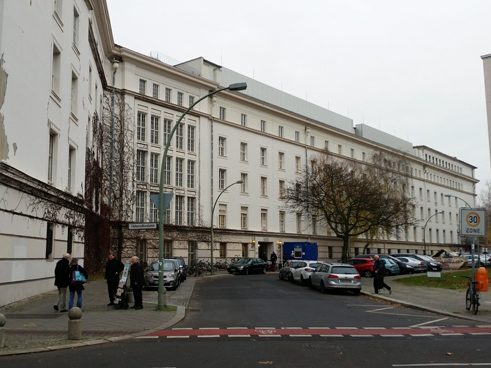 © Andrea Marshall
© Andrea Marshall
Eine Notunterkunft im Rathaus
Das ehemalige Rathaus des Berliner Bezirks Wilmersdorf wird seit August 2015 als Notunterkunft für Flüchtlinge genutzt. Aus Kostengründen hatte der Bezirk das Gebäude zum Jahresende 2014 aufgegeben – es sollte verkauft werden. Die Mitarbeiter zogen in andere, kostengünstigere Räumlichkeiten um. Danach stand der denkmalgeschützte Altbau einige Monate lang leer.
-
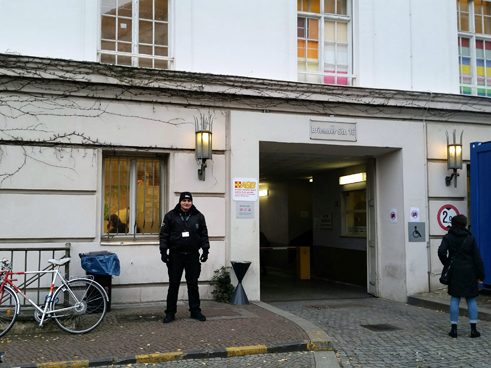 © Andrea Marshall
© Andrea Marshall
Sicherheitsmaßnahmen
Wachpersonal kontrolliert, wer das Gebäude betritt und wer es verlässt. Eine Sicherheitsmaßnahme, denn mit der Zahl der Zuwanderer in Deutschland ist auch die Zahl der Anschläge auf Flüchtlingsquartiere stark gestiegen. Die meisten Wachleute haben selbst ausländische Wurzeln und können sich mit den Flüchtlingen auf Arabisch oder in anderen Sprachen unterhalten.
-
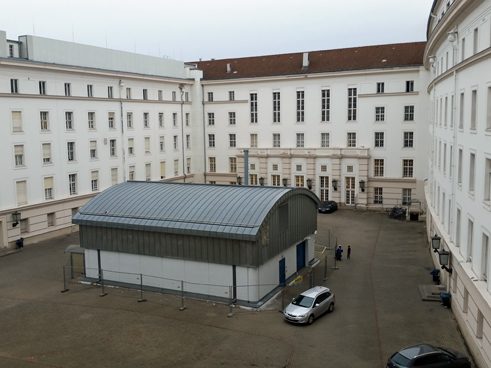 © Andrea Marshall
© Andrea Marshall
Im Hof
Es ist kaum zu glauben, dass in dem ehemaligen Verwaltungsgebäude fast 1.000 Menschen leben. An Wochentagen sind viele Bewohnerinnen und Bewohner in der Stadt unterwegs. Sie müssen die Formalitäten für eine Aufenthaltserlaubnis oder einen Antrag auf politisches Asyl in Deutschland regeln. Schon die Terminvergabe beim zuständigen Amt kann mehrere Wochen dauern.
-
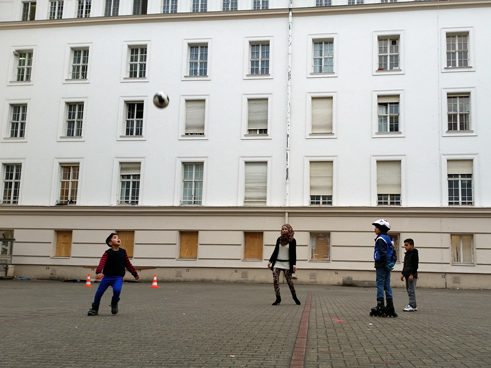 © Andrea Marshall
© Andrea Marshall
Spielende Kinder im Hof
Viele Kinder und Jugendliche besuchen bereits eine sogenannte Willkommensklasse in einer Berliner Schule, um die deutsche Sprache zu lernen. Andere müssen noch auf einen Schulplatz warten. Alle Flüchtlingskinder haben in Deutschland das Recht, eine Schule zu besuchen – auch wenn noch nicht geklärt ist, ob sie im Land bleiben dürfen.
-
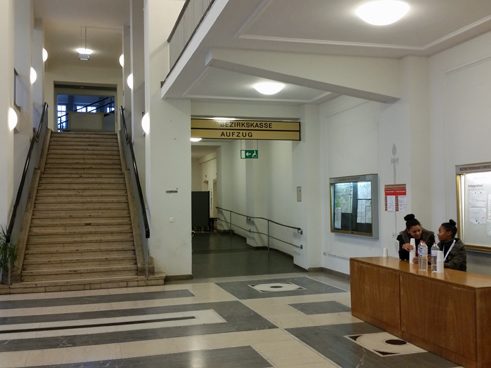 © Andrea Marshall
© Andrea Marshall
Die Eingangshalle
In der pompösen Eingangshalle zum früheren Rathaus warten die Berliner Gymnasiastinnen Clara (links) und Zaina auf Abnehmer für Erfrischungen. Die Mädchen absolvieren ihr Schulpraktikum im Flüchtlingsheim.
-
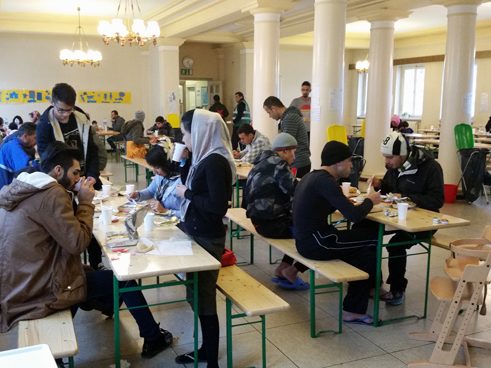 © Andrea Marshall
© Andrea Marshall
Die Kantine
Zwischen 7 Uhr morgens und 22 Uhr hat die Kantine im obersten Stockwerk geöffnet. Der Essenslieferant arbeitet mit türkischen und arabischen Köchinnen und Köchen. Geliefert werden ausschließlich Speisen, die in der muslimischen Esskultur erlaubt sind („halal“).
-
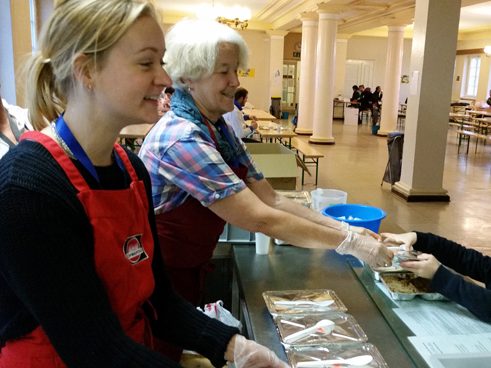 © Andrea Marshall
© Andrea Marshall
Helferinnen
Madeleine (links) kommt aus Schweden. Die gelernte Rechnungsprüferin arbeitet als Ehrenamtliche in der Kantine mit. Sie ist auf Arbeitssuche und hat deshalb genügend Zeit, um auszuhelfen. Auch die pensionierte Lehrerin Lynn aus den USA arbeitet regelmäßig als Freiwillige in der Notunterkunft in Wilmersdorf.
-
 © Andrea Marshall
© Andrea Marshall
Freundschaften
Die deutsche Fotografin Heike und die Englischlehrerin Hend aus Syrien haben sich im Frauenraum der Flüchtlingsunterkunft Wilmersdorf kennengelernt. Männer dürfen den Frauenraum nicht betreten, hier sind Bewohnerinnen und Besucherinnen unter sich. Viele Frauen nehmen in dieser geschützten Atmosphäre auch ihr Kopftuch ab. Fotografiert werden wollen sie dabei nicht.
-
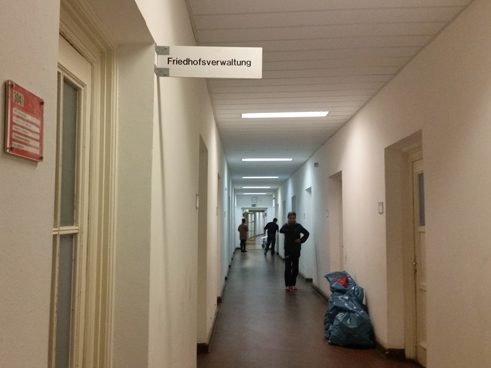 © Andrea Marshall
© Andrea Marshall
In den früheren Büros leben jetzt Menschen
Scheinbar endlose Flure durchziehen das alte Rathaus. In den Büros arbeiteten früher Verwaltungsangestellte. Jetzt leben hier Familien und Einzelpersonen. Im Zimmer fotografiert werden möchten die Flüchtlinge nicht.
-
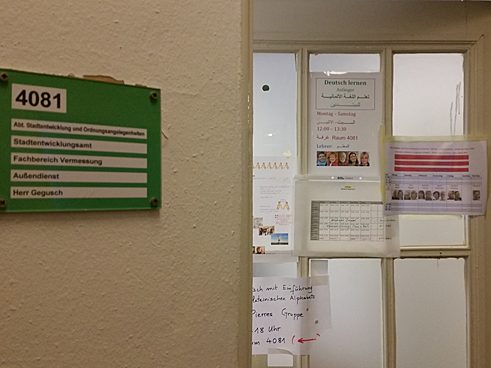 © Andrea Marshall
© Andrea Marshall
Deutschunterricht
In diesen Räumlichkeiten war einst das Berliner Vermessungsamt untergebracht. Heute findet hier Deutschunterricht für Geflüchtete statt, deren Muttersprache Urdu ist. Einige Flüchtlinge, die in ihrer Heimat als Lehrerinnen oder Lehrer gearbeitet haben, bieten Alphabetisierungskurse für ihre Landsleute an.
-
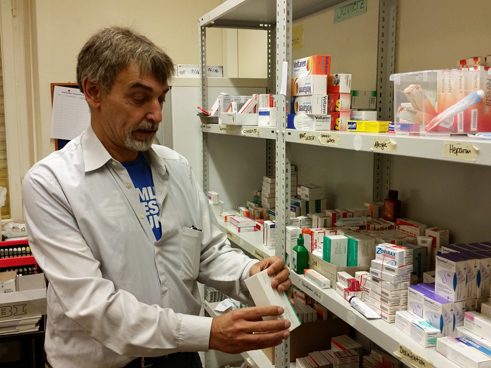 © Andrea Marshall
© Andrea Marshall
Medizinische Spenden
„Jedes Medikament, jede Liege und jeder Notfallkoffer hier sind gespendet worden – sogar das Ultraschallgerät“, erklärt Jens. Er hat als Pfleger und IT-Spezialist im Krankenhaus gearbeitet. Im Flüchtlingsheim hilft er unter anderem, die Räume für die Gynäkologie und die psychiatrische Betreuung einzurichten.
-
 © Andrea Marshall
© Andrea Marshall
Der Waschraum
Im Waschraum kümmert sich Mitarbeiterin Lidia um die Maschinen und Trockner. Auch ein Friseursalon und die zweite Schneiderei im Haus sollen bald eröffnen. Gespendete Nähmaschinen sind schon vorhanden.
-
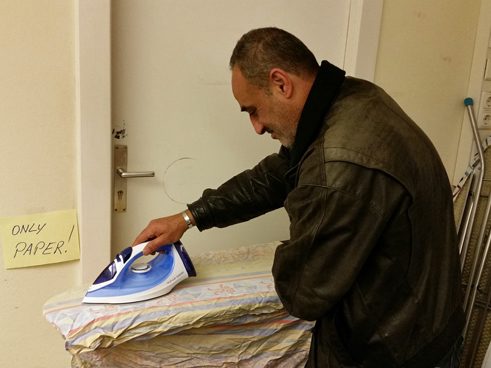 © Andrea Marshall
© Andrea Marshall
Bügeln
Bügeln ist offensichtlich nicht nur Frauenarbeit im Waschraum.
-
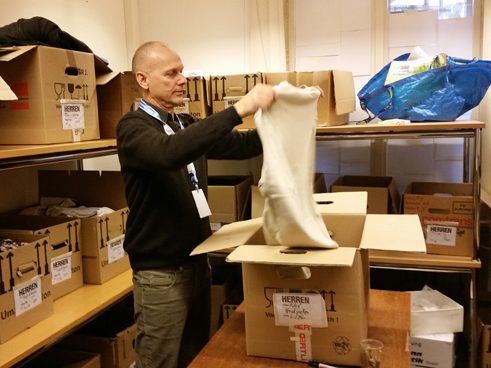 © Andrea Marshall
© Andrea Marshall
Sortieren von Kleidung
Ehrenamtler Uli hilft beim Sortieren der gespendeten Kleidungsstücke – der „Spendenlawine“, wie er es bezeichnet. Kleidung in großen Größen wird selten nachgefragt. Die Flüchtlinge sind meist kleiner und zierlicher als die Deutschen.
-
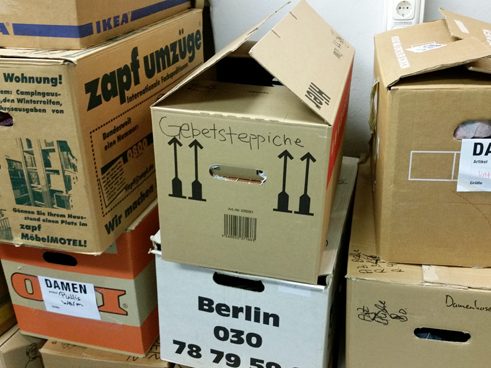 © Andrea Marshall
© Andrea Marshall
Ein Karton mit Gebetsteppichen
Auch gespendete Gebetsteppiche befinden sich im Angebot in der Flüchtlingsunterkunft.
-
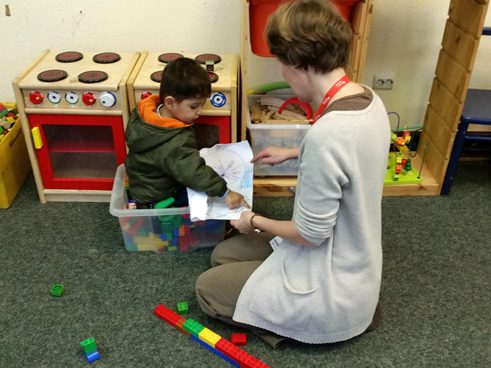 © Andrea Marshall
© Andrea Marshall
Das Spielzimmer
Für die Kleinen gibt es ein Spielzimmer. Wer im Kinderzimmer ehrenamtlich mithelfen möchte, benötigt ein erweitertes Führungszeugnis von der Polizei.
-
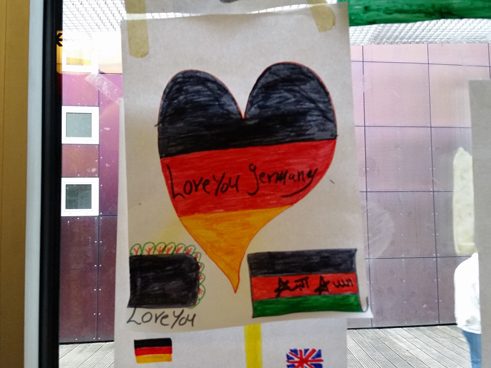 © Andrea Marshall
© Andrea Marshall
Ein Dankeschön
Die Dankbarkeit der Flüchtlingskinder ist eines der schönsten Geschenke, das die Freiwilligen bekommen.
#PromisedLand
